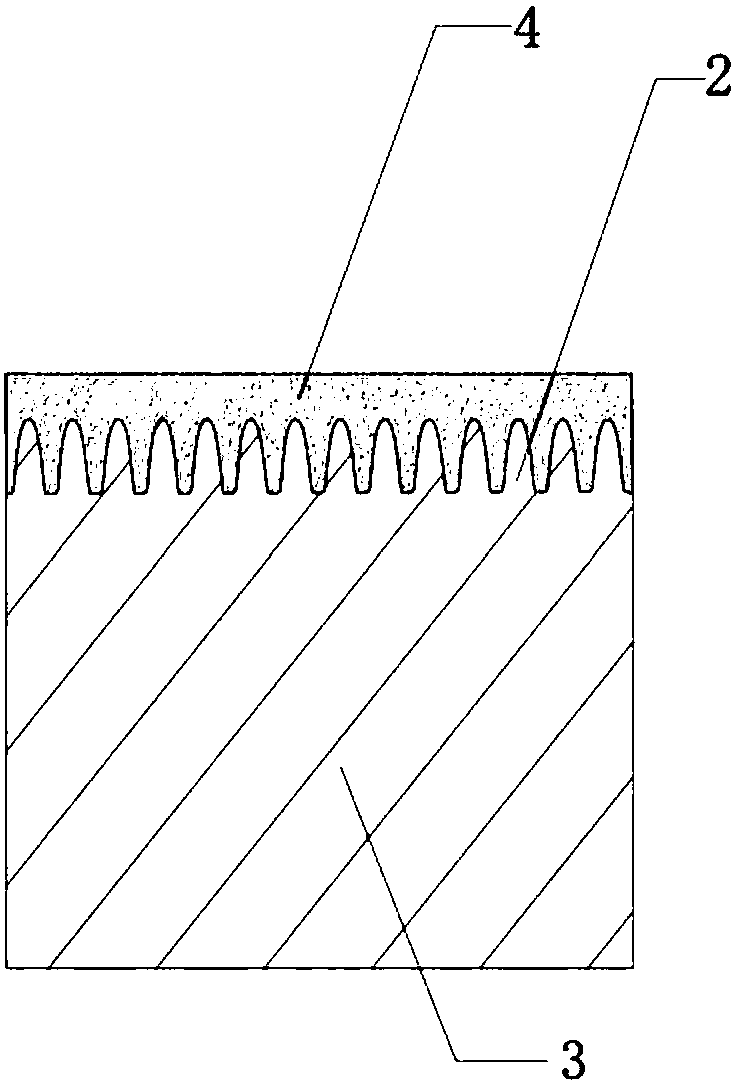A production method of color-changing peacock feather decorative ceramic tile
A technology of peacock feathers and production methods, which is applied in the field of decorative tiles, can solve the problems of no glaze texture changes, etc., and achieve the effect of increasing detail changes, enhancing three-dimensionality and fidelity, and presenting realistic surface colors
- Summary
- Abstract
- Description
- Claims
- Application Information
AI Technical Summary
Problems solved by technology
Method used
Image
Examples
Embodiment 1
[0024] 1) Preparation of textured ceramic body:
[0025] see figure 1 , using the ceramic mold 1 with the concave-convex texture line 2 similar to the peacock feather to press the ceramic body, and the surface of the ceramic body is trimmed to obtain a textured ceramic body 3;
[0026] 2) Preparation of blue glaze paste:
[0027] Mix 55% of feldspar, 30% of quartz, 10% of calcite, 3% of talc, and 2% of cobalt blue material by mass percentage to obtain a mixture, and then add 0.4% of the mixture to the mixture. The sodium tripolyphosphate and 1% CMC are mixed evenly, finely ground to 250 mesh, and the specific gravity of the prepared glaze slurry is 1.6-1.7g / cm 3 get blue glaze paste;
[0028] 3) see figure 2 , uniformly apply the blue glaze slurry on the textured ceramic body 3, enter the kiln and heat it up to 1150 ° C in a reducing atmosphere, keep the temperature for 30 minutes, and naturally cool to obtain a blue glaze layer 4 with blue glaze layer 4. glazed tiles; ...
Embodiment 2
[0032] 1) Preparation of textured ceramic body:
[0033] see figure 1 , using the ceramic mold 1 with the concave-convex texture line 2 similar to the peacock feather to press the ceramic body, and the surface of the ceramic body is trimmed to obtain a textured ceramic body 3;
[0034] 2) Preparation of blue glaze paste:
[0035] Mix 60% of feldspar, 20% of quartz, 10% of calcite, 5% of talc, and 5% of cobalt blue material by mass percentage to obtain a mixture, and then add 0.4% of the mixture to the mixture The sodium tripolyphosphate and 1% CMC are mixed evenly, finely ground to 250 mesh, and the specific gravity of the prepared glaze slurry is 1.6-1.7g / cm 3 get blue glaze paste;
[0036] 3) see figure 2 , apply the blue glaze slurry evenly on the textured ceramic body 3, enter the kiln and heat it up to 1200°C in a reducing atmosphere, keep the temperature for 15 minutes, and naturally cool to obtain a blue glaze layer 4 with blue glaze layer 4. glazed tiles;
[003...
Embodiment 3
[0040] 1) Preparation of textured ceramic body:
[0041] see figure 1 , using the ceramic mold 1 with the concave-convex texture line 2 similar to the peacock feather to press the ceramic body, and the surface of the ceramic body is trimmed to obtain a textured ceramic body 3;
[0042] 2) Preparation of blue glaze paste:
[0043] Mix 70% of feldspar, 20% of quartz, 5% of calcite, 2% of talc, and 3% of cobalt blue material by mass percentage to obtain a mixture, and then add 0.4% by mass of the mixture to the mixture The sodium tripolyphosphate and 1% CMC are mixed evenly, finely ground to 250 mesh, and the specific gravity of the prepared glaze slurry is 1.6-1.7g / cm 3 get blue glaze paste;
[0044] 3) see figure 2 , apply the blue glaze slurry evenly on the textured ceramic body 3, enter the kiln and heat it up to 1250°C in a reducing atmosphere, keep the temperature for 10 minutes, and naturally cool to obtain a blue glaze layer 4 with blue glaze layer 4. glazed tiles; ...
PUM
 Login to View More
Login to View More Abstract
Description
Claims
Application Information
 Login to View More
Login to View More - R&D
- Intellectual Property
- Life Sciences
- Materials
- Tech Scout
- Unparalleled Data Quality
- Higher Quality Content
- 60% Fewer Hallucinations
Browse by: Latest US Patents, China's latest patents, Technical Efficacy Thesaurus, Application Domain, Technology Topic, Popular Technical Reports.
© 2025 PatSnap. All rights reserved.Legal|Privacy policy|Modern Slavery Act Transparency Statement|Sitemap|About US| Contact US: help@patsnap.com



